Kuala Lumpur Travel Report Part 2
I had to check out of my lovely hotel room already on Sunday morning, left my luggage where it was and headed again for Pasar Seni, the central market. From its platform you can see the construct of the national mosque and that was where I wanted to go, but easier said than done. After a labyrinth of elevated walkways over a stinking and neglected river, I ended at another half-abandoned looking station and saw yet another motorway blocking the access to the mosque.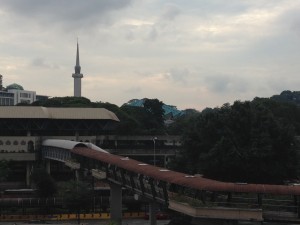
There was a lost looking young girl around and I addressed her and she also wanted to go to the mosque and so we tried together. She was from Spain (I’m afraid I forgot her name) and had just started with a one-year-around the world trip (ah nice!). Malaysia was her second place to visit, the first had been Japan.
We descended from the elevated walkway to the weird platform of this abandoned looking station, searching for a way out. Further south, the station turned out to be half in use, called Kuala Lumpur and it looked to me like it was the former main station, which was now replaced with the more modern KL Sentral Station one stop further south. The defunct building was neglected and spooky and I was glad for having company. We managed to get out, doubled back towards the mosque and ended up having to cross the motorway on foot, which we apparently both survived. I wonder how the regular visitors of the mosque get there… arrived at the mosque we found it again closed to non-believer visitors………. Again our two (different) guide maps said the mosque would be open for visitors until 13:00 but it was only open until 12:00… so far for two in-vain attempts to get into Malaysian mosques.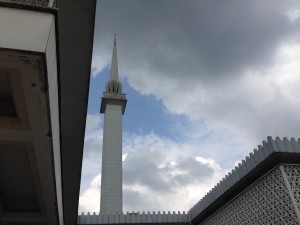
The Spanish girl and I sat down on a bench in the mosque’s park and debated what to do next. She wanted to have lunch, I just had a giant breakfast at the hotel and wasn’t hungry. She asked whether I had been to the Batu caves and I said no and she highly recommended me to go there. I had seen them in the guidebook but thought it was too much hustle to get there. By nice coincidence, the train there left right from the Kuala Lumpur station where we were at and so I decided spontaneously to follow her advice and we ventured back over the motorway to the station. She wanted to go to Pasar Seni to grab lunch and I was lucky that just a train to the Batu caves arrived, hoped on and waved good-bye to the Spanish girl. Thanks for the tip with the caves and good travels for the year to come!
The train was a highly welcome source of cool. It took only 25 min to get out of Kuala Lumpur and to the caves in the north. Kuala Lumpur is pretty flat and out of nowhere lime stone cliffs arise that are hollowed out by numerous caves.
There are three caves in total, let me call them the “ornament” cave, the “temple” cave and the “natural” cave.
The closest to the station was the ornament cave and accompanied by garbage checking monkeys, I paid 2 ringitt to get into the cave. Inside waited quite a surprise. Apart from being a stalactite cave there were hundreds of 3D papier mache figures describing scenes from an Indian religious canon centering around a god (I suppose) who has the body of a man but the face of a monkey. The cave was heftily lit and had two waterfalls on offer plus quite impressive stalactites and stalacmites.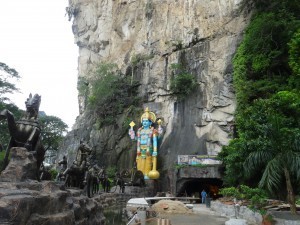
The most notable one was an alien-egg like cone that seems to have religious significance and was roped off. Two Indians asked me to take pictures of them in front of it. As for the ornaments, the most impressive one was a eleven-or-so faced king? whom the monkey god pointed at. Neither of them looked friendly in that scene. The entire ornament cave was bizarre and also tacky to Western eyes, but chubby-cheeked and bodied naked angels with white wings in Bavarian romantic churches surely look equally bizarre and tacky to Asian eyes.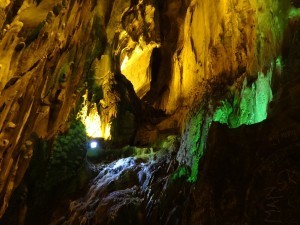
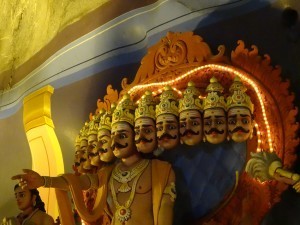
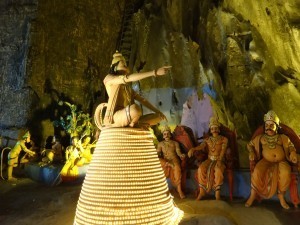
On I ventured past the temple on the ground and arrived at a giant golden statue of another god (a godess in this case) when it started to rain and thunderstorm mightily. More caves promised to be at the end of some hundreds of stairs but I waited a bit under a roof for the worst rain to stop. While it was still drizzling, I went up the stairs and passed by a side track with a sign saying “dark caves”. Oh, let’s explore those on the way back.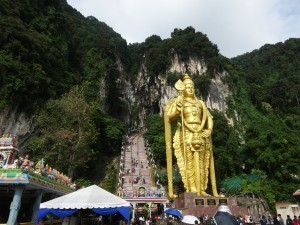
The temple cave on top of the mountain was impressive. Its main chamber was huge, over 70 meters high as the guide books said and what an interesting mix of religion, commerce, and nature the cave had to offer. Inside was a souvenir booth, a heap of industrial dirt, pipes, old machines, sacks with rubbish, and at the end of it more stairs to somewhere where natural light trickled in from above. I walked there and climbed the stairs to a fantastic round, sink-hole like opening in the mountain, with a small temple at the ground and trees protruding in wild angles from the rocks. The sink-hole with its temple inside was utterly beautiful and worthy of a movie location. The bizarre landscape was made even weirder by a cock carking half the time which ran around human feet inside the temple and apparently belonged there.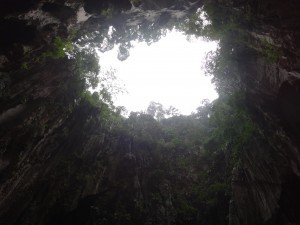
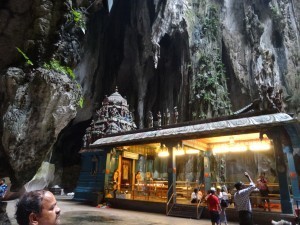
After making a hundred photos of the sink-hole, I finally pried myself loose and went back to the “dark cave” sidetrack. At the entrance to darkness stood a small booth where you could buy tickets for a dark cave tour and the next one would start 20 min later (and last about 45 min), waiting, I had a welcome rest at the cave’s entrance.
Equipped with helmets and flashlights some 15 tourists followed a guide girl, who led us into the publicly accessible part of the cave. The cave system is quite extensive and the girl said there were more than 200,000 bats living in it. You could hear them chattering above you and I saw one or the other batman flying by too. The girl looked like a student of biology to me, she was very knowledgeable about the wildlife in the cave and introduced us to several of its critters, including ten centimeter long centipedes with very long antennae… yuk! She said that in the 70ties this had been a tourist spot already and the caves had been lit up (like the ornament cave), a concrete path had been built through it and people had come unguided and had pick-nicks in the cave. Then, in the 80ties some environmental awareness kicked in and the tourists had been banned, the lights killed and guided tours had been established. Now you are not allowed to eat and drink in the cave, not allowed to leave the concrete path and don’t shine your light up at the bats! The guide lady revealed some beautiful rock formations with her bigger torch and led us until the grand hall, which has an access to the outside much like the sink-hole of the temple cave. I really liked our lady guide, you could feel and hear that she cared for the cave and the creatures inside it and I’m happy I made the tour.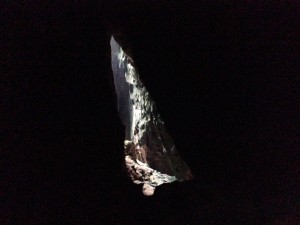
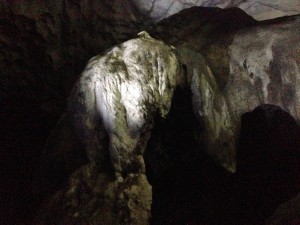
That were enough caves for one day for me though and time was also pressing, so I left the cave mountain walking down the giant stairs with monkeys jumping around me.
I’m very glad for having met that Spanish girl and having ventured to the Batu caves, which are very much worth a visit.
I rode by train back to the awkward Kuala Lumpur station and by subway back to the Petronas Towers, had some snacks in the garden behind them and then picked up my luggage from the hotel to ride by taxi to Kuala Lumpur airport.
Having seen so much of Kuala Lumpur and surroundings left no time for sightseeing in Penang, of which I basically only saw the airport, the hotel and our plant/office. I hope to get the opportunity to go again to Penang some time and see a bit more of that town.
One more general thing remains to be said – I had the impression that everyone in Malaysia speaks English. Might be the old influence of the once-British colony but I found it to be very practical and making things very easy if even the taxi driver understands you, in contrast to e.g. China (or Japan for that matter). Malaysia left a very good impression on me and I hope to be able to go there again one day.



